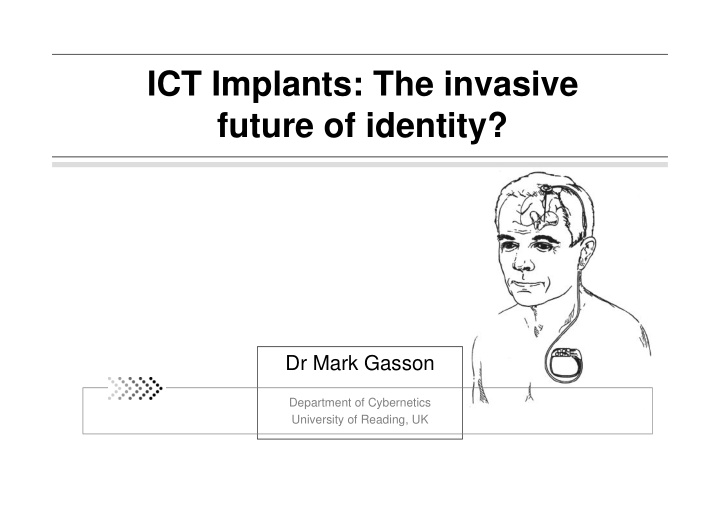



ICT Implants: The invasive future of identity? Dr Mark Gasson Department of Cybernetics University of Reading, UK
Objectives . . . - An overview of the state-of- the-art - Establish a scientific basis for some futuristic claims - Generate discussion on this important topic
Objectives . . . - An overview of the state-of- the-art - Establish a scientific basis for some futuristic claims - Generate discussion on this important topic Not an objective . . . - To necessarily defend anything as right, wrong, moral, ethical or other.
Introduction to Implantable Devices - Restorative : restore lost functions and replace lost organs and limbs - Normalising : restore some creature to indistinguishable normality - Reconfiguring : creating post- humans equal to but different from humans - Enhancing : nobody mention ‘the matrix’, please
Introduction to Implantable Devices Emerging technologies - new and potentially disruptive technologies: nanotechnology, biotechnology, information technology, cognitive science, robotics, AI etc, etc . . . . . . clusters of technologies that are considered critical to humanity's future
Introduction to Implantable Devices ICT IMPLANTS
Introduction to Implantable Devices ICT IMPLANTS = Ethics
Introduction to Implantable Devices ICT IMPLANTS = Ethics + RFID???
ICT Implants = RFID?
RFID Seriously, would anyone really implant an RFID tag?
Chip on the Shoulder?
RFID Well, good for them… But I don’t want one.
Passive Medical Devices? – artificial joints – vascular implants – artificial valves – . . .
Active Medical Devices
Active Medical Devices Cardiovascular pacers Cochlear and brainstem implants Deep brain stimulation Spinal cord stimulation Sacral nerve stimulation Vagus nerve stimulation Drug delivery pumps Intrathecal administration of Baclofen …
Active Medical Devices
Active Medical Devices?
Onwards and Upwards . . . – Interfaces with the Central Nervous System
Active Medical Devices
Active Medical Devices
A Case Study: Deep Brain Stimulation
A Case Study: Deep Brain Stimulation Why use Deep Brain Stimulation? • Alleviates the motor symptoms of conditions such as Parkinson’s Disease • Avoids the disabling side effects of long term treatment with L-dopa by reducing medication requirements • An option following failure of conventional drug treatments • Similar effects to lesioning, but largely reversible
A Case Study: Deep Brain Stimulation What is Deep Brain Stimulation? Implanted Electrodes • Classic DBS uses continuous stimulation of deep brain structures (thalamus, sub-thalamus or globus Lead pallidus for the treatment of tremor, Parkinson’s, dystonia and pain) • Suppression of symptoms occurs at amplitudes of 1-8mA, pulse widths of 60-120µsec, and rates of 130-185Hz • It is hypothesised that DBS locks neurons to every 5th-10th stimulus preventing the slow synchronous cycles that may cause motor Neurostimulator symptoms
Developing a Demand Driven Stimulator STFT spectrogram of sub- thalamic nucleus LFPs and forearm extensor surface EMGs during the onset of resting tremor
Developing a Demand Driven Stimulator STFT spectrogram of globus pallidus LFPs and forearm extensor surface EMGs during the onset of resting tremor
The Future?
Thank you Q&A
Recommend
More recommend